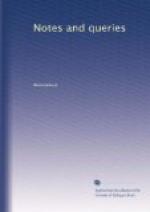“This curious and interesting volume appears to have been kept purposely for the various clergymen to write their receipts for preaching the morning lectures at the above church for nearly a century and a half. It contains the autographs of many eminent divines; among others, John Goodwin, R. Pearson, J. Berriman, J. Withers, J. Cooksey, R. Vann, T. Shepperd. W. Scott, R. Chambre, J. Todd, Lilly Butler, J. Botham, C. Evans, T. Clarke, J. Williams, J. Povey, J. Hotchkis, W. Stringfellow, W. Pott, C. Bancroft, R. Clarke, W. Gearing, and many others.”
“The Chuchwarden and
Overseers of the Parish of St. Antholin’s
in London, Accounts from 1638
to 1700 inclusive. Folio, 3l. 3s.
“An interesting record of the expenses of this parish for sixty-four years. It commences with the gifts of various sacks of coals, faggots, &c., to the poor, receipts for flesh licences, collections, interest money, the Lady Martaine’s gifts, Sir W. Craven’s gifts, the Merchant Tailors’ Company’s gifts, Mercers’ ditto, the Company of Ironmongers forty fagots, the Company of Mercers a load of charcoal, the gift of the late King James seven loads of Newcastle coals,—this royal bequest appears to have been annual gift for ever. Query, if now in payment? ANNUAL gifts of Lady Coventry for putting out two poor children born in this parish. Lady Martin’s, and many others, are annual gifts, which ought to be forthcoming to the parish at this time.”
This last note contains some Queries which I should be glad to see answered.
EDWARD F. RIMBAULT. {173}
The Plant “Haemony" (Vol. ii. p. 88. and p. 141.).—The mystical meaning of “Haemony” is evolved by Coleridge in a passage which occurs in his Statesman’s Manual, appendix B., and which cannot fail to interest the readers of Comus.
“It is found in the study of the Old and New Testament, if only it be combined with a spiritual partaking of the Redeemer’s blood, of which, mysterious as the symbol may be, the sacramental wine is no mere or arbitrary memento. This is the only certain, and this is the universal, preventive of all debasing superstitions; this is the true haemony ([Greek: haima], blood, [Greek: oinos], wine), which our Milton has beautifully allegorised in a passage strangely overlooked by all his commentators. Bear in mind, reader! the character of a militant Christian, and the results (in this life and in the next) of the redemption by the blood of Christ, and so peruse the passage.”
T.M.B.




